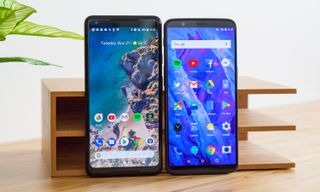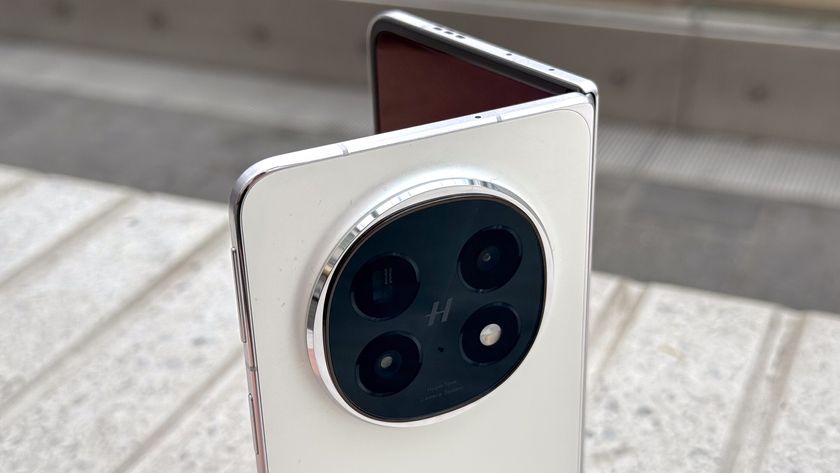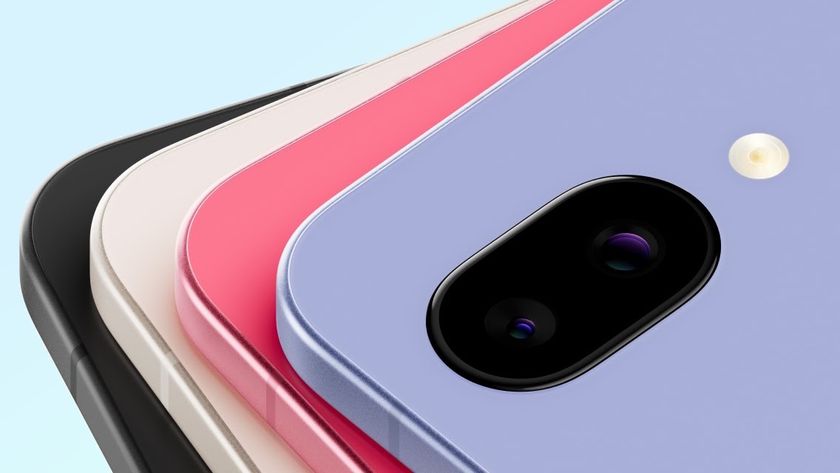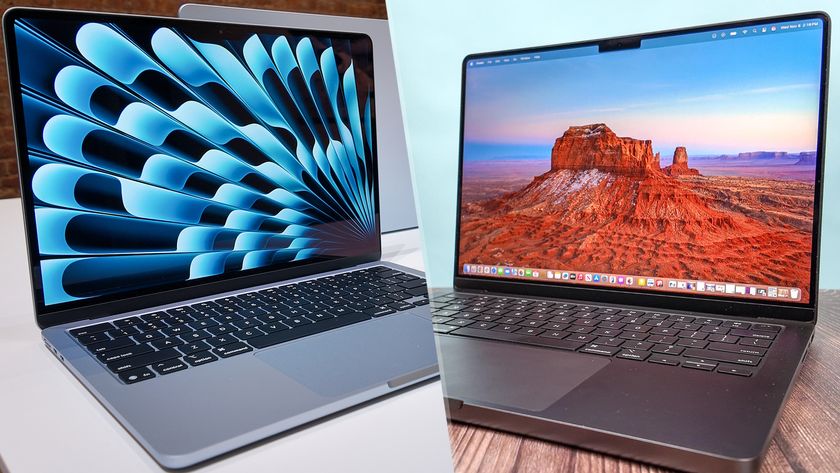OnePlus 5T vs Pixel 2: Why OnePlus Wins
The OnePlus 5T doesn’t just promise the flagship features on the cheap, it beats the Pixel 2 and Pixel 2 XL in some key categories.
Editors' Note: We've updated this article to note that the OnePlus 5T has an issue streaming HD video on Netflix.
The OnePlus 5T packs in a lot of the things people look for in a smartphone — a long-lasting battery, blazing processor and feature-rich camera — into a device that embraces the move toward edge-to-edge screens. But it's missing something people aren't such big fans of: a big price tag. Though the new phone from OnePlus matches the feature list of many leading flagships, it costs a couple hundred dollars less than the best phones from Apple, Google and Samsung.

Just what do you give up if you're looking to save, though? To find out, we put the $499 OnePlus 5T up against two other leading flagships that boast best-in-class features: Google's new $649 Pixel 2 and $849 Pixel 2 XL. It turns out the competition between these phones is a lot closer than you might think.
OnePlus 5T vs Pixel 2 and Pixel 2 XL: Specs Compared
| Row 0 - Cell 0 | OnePlus 5T | Google Pixel 2 | Google Pixel 2 XL |
| Price | $499/$549 | $649/$749 | $849/$949 |
| OS | Android 7.1.1 Nougat with OxygenOS | Android 8.0 Oreo | Android 8.0 Oreo |
| Screen Size (Resolution) | 6 inches (2160 x 1080) AMOLED | 5 inches (1920 x 1080) AMOLED | 6 inches (2880 x 1440) pOLED |
| CPU | Qualcomm Snapdragon 835 | Qualcomm Snapdragon 835 | Qualcomm Snapdragon 835 |
| RAM | 6GB/8GB | 4GB | 4GB |
| Storage | 64GB/128GB | 64GB/128GB | 64GB/128GB |
| microSD Slot? | No | No | No |
| Rear Camera | Dual 16 MP (f/1.7) and 20 MP (f/1.7) | 12.2 MP (f/1.8) | 12.2 MP (f/1.8) |
| Front Camera | 16 MP (f/2.0) | 8MP (f/2.4) | 8MP (f/2.4) |
| Battery Life (Hrs:Min) | 11:22 | 11:07 | 12:09 |
| Water Resistance | No | Yes (IP67) | Yes (IP67) |
| Size | 6.1 x 2.9 x 0.3 inches | 5.7 x 2.7 x 0.3 inches | 6.2 x 3 x 0.3 inches |
| Weight | 5.7 ounces | 5.0 ounces | 6.2 ounces |
Design
All three of these phones feature mostly aluminum bodies with fingerprint sensors located on the back, although each looks quite different. The 5-inch Pixel 2 has the most dated design of the bunch, with chunky bezels above and below the display and a screen with a conventional 16:9 aspect ratio. However, its small size makes it the easiest to use in one hand.

Meanwhile, the Pixel 2 XL uses an 18:9 plastic OLED panel, courtesy of LG, which fills most of the phone's frame. The bezels aren't superthin, but the dramatically curved glass and rounded corners of the screen make it look and feel considerably more modern.
MORE: Best Small Phones
The OnePlus 5T has even smaller bezels, and it's a hair more compact than the Pixel 2 XL, making it slightly less cumbersome to hold. We like the inclusion of a notification light — a feature more common on older Android handsets that we've missed — as well as a 3.5-millimeter headphone jack that's MIA on Google's phone. The 5T also offers a side switch that allows you to toggle between volume on, vibration and silent modes.

However, the finish of the 5T's metal didn't have the same kind of powdered texture we enjoyed using on Google's phones. Furthermore, OnePlus is promising only splash resistance with the 5T, not the IP67 protection that's found in both Pixel 2 models.
Design Rank: 1st: OnePlus 5T, 2nd: Pixel 2 XL, 3rd: Pixel 2
Display
Both the 5-inch Pixel 2 and 6-inch OnePlus 5T utilize Samsung AMOLED displays with similar resolutions: 1920 x 1080 for the Pixel 2, and 2160 x 1080 for the 5T. Because the Pixel packs nearly the same number of — well, pixels — in a smaller space, it sports a greater density, which means images appear sharper to the naked eye.

Overall, these are two solid screens with excellent viewing angles, brightness and a choice of color display modes. The 5T's stock setting is quite vivid, though there are optional sRGB and DC1-P3 profiles for more realistic colors. The Pixel 2 uses sRGB as standard, but a Boosted option bumps up saturation by 10 percent.

Meanwhile, the Pixel 2 XL's LG-sourced 2880 x 1440 panel has been wracked with issues since release, from complaints over dull hues to burn-in and even a “black smear” effect when dark content moves across the display. Google has released an update in recent weeks that's intended to improve the color and burn-in concerns, but the screen still presents solid blocks of color with a paper-like texture, and its visibility at off-center angles is tinged with a blue cast.
Because of this, we have to make the odd distinction of recommending the smaller Pixel 2's screen, but not the XL. The OnePlus 5T's display is also excellent, especially for its price.
Display Rank: 1st: OnePlus 5T, 2nd: Pixel 2, 3rd: Pixel 2 XL
Cameras
The OnePlus 5T's dual 16- and 20-megapixel cameras are great for their price, but they're no match for the single 12-MP lens in either the Pixel 2 and Pixel 2 XL. Still, the 5T puts up a respectable fight.
In this shot of an outdoor cafe, we see that the results from both devices are very close. The Pixel 2 displays a tint that's ever so slightly warmer, while the OnePlus 5T surprisingly performs a little better in the shadows. The 5T's higher megapixel count also helps it preserve more detail as you zoom in.
Unfortunately, things quickly fell apart for the OnePlus. This challenging scene of sunlight breaking through the leaves behind a dark statue tested the HDR capabilities of both devices.
Immediately, it's easy to see that Pixel 2 passes with flying colors. Google's phone somehow manages to capture everything from the deep blue of the sky to the gold leaves, intricacies of the marble and the metallic finish of the statue itself. Nothing is under- or overexposed; all parts of the frame are equally crisp in detail, from the foreground to the background. It's an impressive performance.
The OnePlus 5T, on the other hand, struggles the way you'd expect most phones would, and even its HDR mode couldn't save it. The result is a blurry mess, with blown-out highlights, pitch-black shadows, and none of the depth and clarity of the Pixel 2's shot. For an otherwise solid pair of cameras, the 5T definitely underwhelmed here.
Fortunately, the OnePlus picked itself up in time for this last photo, a shot of a crosswalk near New York's Flatiron Building. The Pixel 2's colors pop just a bit more here, but interestingly, the OnePlus' megapixel advantage isn't as apparent. If you zoom in on the asphalt in the foreground, it's Google's phone that actually picks up more detail, while the 5T slightly muddies the threshold between the road itself and the painted lines.
For what you're paying, the OnePlus can produce some excellent photos. Depending on the situation, it can compare favorably against Google's devices; it's nearly there. But the Pixel 2 is firmly in the upper echelon of smartphone cameras, alongside Apple's latest iPhones. And that means it handily wins this round.
Camera Rank: 1st: Pixel 2 and Pixel 2 XL (tie), 3rd: OnePlus 5T
Performance
Because of how much more Google charges, you'd expect the Pixel 2 and 2 XL to lead the spec race. Surprisingly, that's actually not the case. While all three phones use Qualcomm's Snapdragon 835 processor, the Pixels make do with only 4GB of RAM, while the OnePlus 5T can be had with either 6GB or 8GB, depending on how much you're looking to spend.
MORE: iPhone 8 is World's Fastest Phone
With double the memory, the OnePlus 5T can keep more apps and background processes running at the same time. It can juggle more tasks without being slowed down: It's just snappier and more responsive in general. Now, that's not to say that either Pixel 2 is at all slow — but these are some of the fastest Android phones on the market, and the difference is very slim, as the benchmarks illustrate.

Taking a look at Geekbench 4, which tests overall performance, the Pixel 2 managed a score of 6,282, while the OnePlus 5T ended up the fastest of any non-iPhone we've tested, at 6,674.
In our video-editing test using Adobe Premiere Clip to convert a 4K video file to 1080p, the Pixel edged ahead, with its 2-minute, 55-second time beating out the 5T (3:20). These are pretty evenly matched phones, though the extra RAM gives the nod to the 5T.
Since we first published this face-off, it's come to light that the OnePlus 5T has an issue streaming HD videos in Netflix, a problem Google's phones don't run into. This doesn't affect our evaluation, as OnePlus is working on a software fix, but it's something to keep in mind when considering which phone to get, at least until OnePlus resolves the issue.
Performance Rank: 1st: OnePlus 5T, 2nd: Pixel 2 and Pixel 2 XL (tie)
Battery Life
When it comes to endurance, just about an hour separates all three phones. In the end, it's the Pixel 2 XL's 3,520-mAh battery — the largest of the three — that won the endurance battle, with a time of 12:09 on our test of continuous web surfing over LTE.
MORE: Smartphones With the Longest Battery Life
The smaller Pixel placed last, at 11:07, while the OnePlus 5T about split the difference, lasting 11:22. Ultimately, whichever handset you opt for should last all day with little trouble.
However, we did find the OnePlus 5T was the fastest phone when it came to charging, and by a long shot. In a half-hour connected to the included wall adapter, the Pixel 2 and 2 XL managed to reach 38 and 35 percent from empty. The OnePlus 5T blew them away, reaching 59 percent in that time. After an hour plugged in, the OnePlus 5T was nearly fully charged at 93 percent, while the Pixel 2's battery indicator was at 75 percent.
Battery Rank: 1st: Pixel 2 XL, 2nd: OnePlus 5T, 3rd: Pixel 2
Software and Special Features
As you'd expect, Google's phones arrive running the latest version of Android — 8.0 Oreo — out of the box. The OnePlus 5T lags a bit behind, with 7.1.1 Nougat featuring the manufacturer's own OxygenOS enhancements.

Truthfully, OxygenOS isn't much different from stock Android, though it does feature a number of helpful small features, like App Locker and Parallel Apps, which allow you to lock certain apps behind passwords and duplicate social media apps for multiple accounts. There's also the self-explanatory Do Not Disturb while Gaming, and another feature exclusive to the 5T: Face Unlock. Stock Android supports facial recognition as a method of unlocking, via the built-in Trusted Face feature, but OnePlus' solution is much faster.
Meanwhile, Google bolsters Oreo with a few Pixel 2-specific features, the most notable of which is Active Edge. Squeezing the side of your phone, you can summon the Google Assistant, a more convenient way to access the feature. Both Pixels also offer an Ambient Display, which functions as an always-on lock screen when the phone is sleeping, that can even identify any music playing nearby at all times.

But the most crucial special feature that all Pixel owners are sure to appreciate is Google Lens. Similar in concept to Google's old Goggles initiative, Lens allows you to point the device's cameras at a person, place or object, and call up relevant, context-aware actions, like reviews, directions, transcription and more. It's a feature that's in its infancy, built on the back of Google's AI prowess, but it figures to change the way we use our phones to explore the world around us.
Finally, the last benefit of Google's own handsets is the promise of an extra year of software updates. Most Android manufacturers guarantee only two years of support, so the extra 12 months certainly won't be taken for granted, especially as Apple typically keeps its devices on the latest version of iOS for four years or more.
Features Rank: 1st: Pixel 2 and Pixel 2 XL (tie), 3rd: OnePlus 5T
Price and Availability
There's simply no avoiding it: the OnePlus 5T is straightaway the better value. At $149 less than the smaller Pixel 2 and $349 less than Google's equivalent 6-inch phone, the OnePlus 5T keeps parity in nearly every aspect, save for the photography experience. In the performance category, it even tops Google's best.
And yet, it may turn out that your carrier will influence your device decision. Once again, Google has partnered exclusively with Verizon for the second-generation Pixel. That means, if you want to use a Pixel 2 or 2 XL on Sprint, T-Mobile or AT&T, you will have to buy yours either outright or with monthly financing through the Google Store, and then take it to your preferred network.
MORE: Best Cell Phone Plans
Similarly, the OnePlus 5T is available unlocked — however, only for GSM carriers, such as T-Mobile and AT&T. Like OnePlus' previous flagships, the 5T is not compatible with networks operating on the CDMA standard, such as Sprint, Verizon and Boost Mobile.
Technically, that means that the Pixel 2 is more widely available, while the OnePlus 5T is the better buy if you happen to subscribe to a network it supports.
Price and Availability Rank: 1st: OnePlus 5T, 2nd: Pixel 2 and Pixel 2 XL (tie)
Outlook
| Row 0 - Cell 0 | OnePlus 5T | Google Pixel 2 | Google Pixel 2 XL |
| Design (10) | 8 | 6 | 8 |
| Display (15) | 13 | 13 | 10 |
| Cameras (20) | 16 | 20 | 20 |
| Performance (10) | 9 | 8 | 8 |
| Battery Life (20) | 16 | 15 | 17 |
| Software/Special Features (10) | 8 | 9 | 9 |
| Price and Availability (15) | 13 | 10 | 10 |
| Total | 83 | 81 | 82 |
These are three great devices, without a single wrong choice among them. It just turns out that the one you select will likely be dependent on which carrier you call home.
If you're partial to AT&T or T-Mobile, the OnePlus 5T is the way to go. With the notable exception of the camera, it’s every bit the flagship of Google's own phones, but at a fraction of the price. You also get expanded RAM and a headphone jack.
But that's not the case for everyone. For Verizon and Sprint customers, we recommend the Pixel 2 to users who prefer a more compact device and aren't quite as concerned with battery life, and the Pixel 2 XL for those who want to go big.. The superior camera in both phones presents another reason to go with Google, especially if you take a lot of photos.
Credit: Shaun Lucas/Tom's Guide
Sign up to get the BEST of Tom's Guide direct to your inbox.
Get instant access to breaking news, the hottest reviews, great deals and helpful tips.
Adam Ismail is a staff writer at Jalopnik and previously worked on Tom's Guide covering smartphones, car tech and gaming. His love for all things mobile began with the original Motorola Droid; since then he’s owned a variety of Android and iOS-powered handsets, refusing to stay loyal to one platform. His work has also appeared on Digital Trends and GTPlanet. When he’s not fiddling with the latest devices, he’s at an indie pop show, recording a podcast or playing Sega Dreamcast.












-
chuong.vuong The OnePlus doesn't "win" anything, against the Pixel or a lot of other phones in the US. For about 50% of us mobile subscriber in the US, namely those of us on Verizon and Sprint, the OnePlus is not much more than an expensive paperweight, since it doesn't support our carrier's radio bands. This should be a critical criterion in a comparison.Reply -
dddjks For Seniors on a budget. There is no better high level combination than a OnePlus 5T with a T-Mobile unlimited 55+ plan for Seniors. This unlimited plan is a flat $60/month for two lines.Reply
The review was slightly off about the OnePlus 5T cameras. There are two 16MP cameras and one 20MP camera on the OnePlus 5T. The duo cameras are both F1.7 and one is designed for low level lighting.
In comparison, neither of the other two phones have more than 12MP. -
pdublind Reply
Actually One Plus makes great phones. I have had my 3t for over a year now on T-Mobile. Also why would anyone pick a carrier than a phone? You do it backwards. Pick a device you really love then find a carrier that supports it. Verizon doens't off many good phones except maybe the Pixel, but even that isn't worth it with the 5t having similar specs.20405824 said:The OnePlus doesn't "win" anything, against the Pixel or a lot of other phones in the US. For about 50% of us mobile subscriber in the US, namely those of us on Verizon and Sprint, the OnePlus is not much more than an expensive paperweight, since it doesn't support our carrier's radio bands. This should be a critical criterion in a comparison.
-
pdublind I love my one plus 3t and am getting the 5t. I will switch my service to get the phone I want. Why settle for a device that I am not happy with or pay more for something similar because my carrier won't support my phone? I will carriers to get the one that supports the phone I want. Verizon doesn't have many great phones anyway. The ability to root and have many choices of custom roms is very important to me as well. Stock android no matter what phone/service has been garbage starting with android 7. The fact that you cannot modify the system partition and apps on stock android is a big negative.Reply -
Allen Millington Needs OIS for indoor shots. Needs Verizon coverage for rural areas. If it had both of those, I would have bought it already.Reply -
clint.twilley Left the iphone ranks for first time in 10 years. Went the 5T route. It is responsive with a great battery life. I have enjoyed it so far. It was nice buying cables and a case at reasonable pricing vs the iphone rip off. I would purchase the 5t again. I have not had either Pixel so I cannot compare to those.Reply






